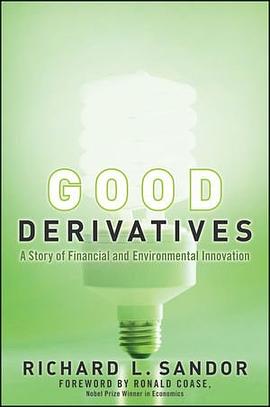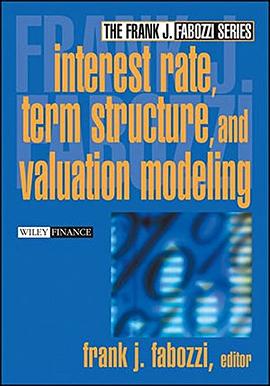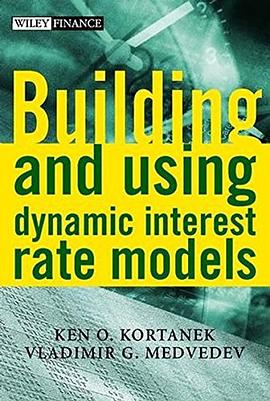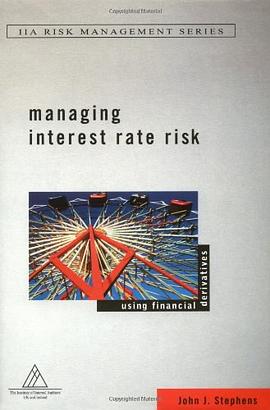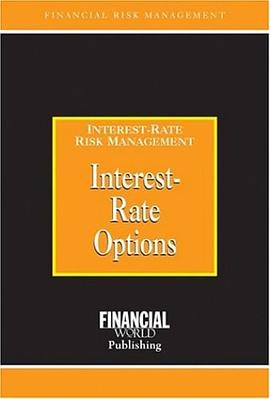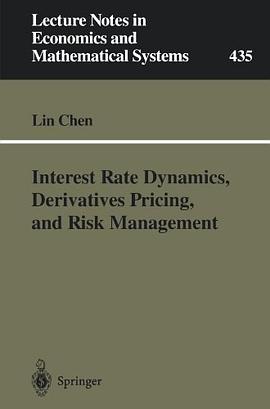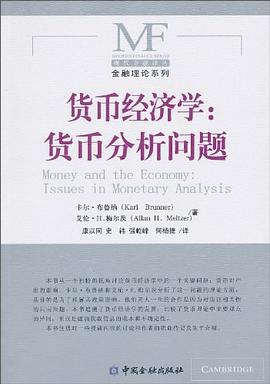

具体描述
作者简介
目录信息
Contents
CHAPTER 1 The Function of Financial Markets
Savings-Investment Foundation
Efficiency of Financial Markets
Stages of Efficiency
Financial Assets
The Role ofFinancial Intermediaries
Disintermediation and Securitization
Country Efficiency
Financial Innovation
The.Catalystfor Change
Types of Innovations
The Implications of Savings
Degrees ofMoneyness
Interest Rates and Arbitrage Efficiency
Summary
Selected References
CHAPTER 2 The Flow-of-Funds System
The Structure of the System
Sectoring
Source and Use Statements
The Preparation ofa Matrix and Its Use
Federal Reserve Flow-of-Funds Data
Credit Flows
Implications ofAnalysis
Summary
Selected References
CHAPTER 3 Foundations for Interest Rates
The Interest Rate in an Exchange Economy
The Individual Choice
Optimum with Exchange
Combined Effect
Market Equilibrium
Interest Rates in a World with Risk
Behavior of Individual Economic Units
Utility for Financial Assets
Utility for Financial Liabilities
Utility for Other Assets
Market Equilibrium
Maximizing Utility for the Economic Unit
TheAction ofAll Economic Units
Summary
Appendix: The Equilibrium Prices of Financial Assets
Market Equilibrium: Two Economic Units
Market Equilibrium: Multiple Financial Assets
Selected References
CHAPTER 4 Prices and Yields for Bonds and Money
Market Instruments
Review of Present Values
Annuities
Present Value When Interest Is Compounded More Than
Once a Year
Continuous Compounding
The Price of a Bond
Coupons and Principal Payments
Price When Next Coupon Payment Is Less Than Six
Months Away
Zero-Coupon Bonds
Yield Calculations for Bonds
Implicit Reinvestment Rate Assumption
Current Yield
Holding Period Return
Yield-to-Maturity for Zero-Coupon Bonds
Yield for Perpetuities
Money Market Instrument Returns
Bank Discount Rate
Implications
Summary
Selected References
CHAPTER 5 Inflation and Retums
The Historical Record in Brief
The Nature of Inflation Premiums
Unanticipated Inflation
The Fisher Effect
Nominal Interest Rates and Inflation, Theoretically
Empirical Evidence on Nominal Interest Rates
Problems in Empirical Testing
Testing for the Effect oflnflation
The Fisher Effect More Directly
A Summing Up
Nominal Contracting Effects
Debtor-Creditor Claims
Depreciation
Inventories
Corporate Value
Empirical Testing
Inflation Indexed Bonds
The Mechanics
Other Aspects
Summary
Selected References
CHAPTER 6 The Term Structure of Interest Rates
Definition of Term Structure
The Pure Expectations Theory
Forward Rates oflnterest
Substitutability of Maturities
Technical Problems
Arbitrage and Market Efficiency
Uncertainty and Term Premiums
Market Segmentation
Cox-Ingersoll-Ross Theory
General Equilibrium Notions
Term Structure Implications
Other Models of the Term Structure
Multifactor Models
Lattice-Type Models
Empirical Evidence
Summary
Selected References
CHAPTER 7 Price Volatility, Coupon Rate, and Maturity
The Coupon Effect
Sensitivity ofPrice to Various Properties
The Duration Measure and Its Changing Behavior
Relationship between Duration and Maturity
Relationship between Duration and Coupon Payment
Relationship between Duration and Changes in Interest Rates
Volatility Duration
Modified Duration Formula
Convexity
The Convexity Measure
Illustration of Price-Change Estimates Using Modified Duration
and Convexity
Further Observations on Convexity
Immunization of Bond Portfolios
Immunization with Coupon Issues
An Illustration
Fisher-Weil Duration
Mapping the Stochastic Process
Testing for Immunization Effectiveness
Additional Immunization Considerations
Equilibration between Coupon and Noncoupon Bond Markets
Coupon Stripping
Term Structure ofPure Discount Bonds
Arbitrage Efficiency between the Markets
Summary
Selected References
CHAPTER 8 The Default-Risk Structure of Interest Rates
Promised, Realized, and Expected Rates
Distribution of Possible Returns
Empirical Evidence on Default Losses
Credit Ratings and Risk Premiums
Some Studies of Bond Ratings
Cyclical Behavior of Risk Premiums
The Market Segmentation Effect
Speculative-Grade (Junk) Bonds
Development ofthe Market
Issuers and Use in Acquisitions
Risk versus Return
Event Risk
Risk Structure and the Term Structure
Empirical Evidence
Summary
Selected References
CHAPTER 9 Derivative Securities: Interest-Rate Futures
Introduction to Contract
Features of Futures Markets
Money Market Instruments
Contents Vll
Margin Requirements
Marking-to-Market and Price Movements
Longer-Term Instruments
Quality Delivery Options
Hedging and Speculation
Some Hedging Fundamentals
Futures and Spot Prices
Long Hedges
Hedge Ratios
Short Hedges
Basis Risk
More on Basis Risk
Sources ofBasis Risk
Market Efficiency
Possible Reasons for Deviation of Forward
and Futures Rates
Summary
Selected References
CHAPTER 10 Derivative Securities: Options
Option Valuation
Expiration Date Value ofan Option
Valuation Prior to Expiration
Hedging with Options
Black-Scholes Option Model
Debt Options
Features ofFutures Options
Use ofDebt Options
Caps, Floors, and Collars
Valuation ofDebt Options
Yield Curve Options
Convertible Securities
Conversion Price/Ratio
Debt Plus Option Characteristic
Value of Convertible Securities
Premiums
Other Reasons for Premiums
Summary
Appendix A: Put-Call Parity
Appendix B: Application of Option Pricing Concepts to Valuing
Convertible Securities
Selected References
CHAPTER 11 Derivative Securities: Swaps
Swap Features
An Illustration
Valuation Issues
Comparative Advantage
Completing Markets
Default Risk
Skirting Tax Laws and Regulations
Swap Valuation: A Summing Up
Credit Risk, Maturity, and Systemic Risk
Default Provisions
Value at Risk
Secondary Market Values
Swaptions
Summary
Selected References
CHAPTER 12 Embedded Options and Option-Adjusted
Spreads
Option-Adjusted Spreads
The Basic Methodology
An Illustrdtion
Some Caveats
The Nature of the Call Feature
Forms ofthe Provision
Redemption versus Callability
Putable Bonds
The Call Feature's Valuation
Interest-Rate Expectations
The Call Feature and Convexity
Valuation in an Option Pricing Context
Empirical Evidence on Call Valuation
The Sinking Fund
Characteristics ofthe Provision
Value ofthe Sinking Fund
Empirical Evidence
Summary
Selected References
CHAPTER 13 Mortgage Securities and Prepayment Risk
Some Features of Mortgages
Mortgage Pass-Through Security
Agency Pass-Throughs
Nonagency Pass-Throughs
Mortgage Derivatives
Collateralized Mortgage Obligations (CMOs)
Planned Amortization Class (PAC) and Targeted Amortization
Class (TAC) Securities
Stripped Mortgage-Backed Securities
Floaters and Inverse Floaters
Prepayment Option and Its Valuation
Prepayment and Convexity
Measures of Prepayment
Coupon Rate and Age
Additional Factors Explaining Prepayment
Modeling Prepayment Experience
Option-Adjusted Spread Approach
Prepayment Behavior of Certain Derivatives
Planned Amortization Class Securities
Interest Only (lOs), Principal Only (POs) and Residual Class Securitie
Other Asset-Backed Securities
Summary
Selected References
CHAPTER 14 Controlling Currency Risk
Risk and Return from Foreign Investment
Exchange Rate Risk Management
Forward Exchange Market
Illustration of Spot and Forward Exchange Rates
A Single European Currency (Euro)
Underlying Relationships
The Law of One Price
Purchasing Power Parity
Interest-Rate Parity
Covered Interest Arbitrage
Interest-Rate Parity Approximation
Empirical Evidence Concerning Interest-Rate Parity (IRP)
Other Ways to Shift Risk
Currency Futures
Currency Options
Currency Swaps
Currency/interest-Rate Swaps
Valuation Implications
The Amount to Hedge
A Free Lunch?
The Cost of Currency Hedging
Black's Universal Hedging
Closing Thoughts
Some Institutional Characteristics
Euro and Foreign Bonds
Currency-Option and Multiple-Currency Bonds
Summary
Selected References
CHAPTER 15 TheInfluenceofTaxes
Tax Treatment of Capital Gains
Original Issue Discount (OID) Bonds
Capital Gains Treatment for Taxable Coupon Bonds
The De Minimis Rule
Capital Gains Treatment for Municipal Bonds
Tax Timing Options
Municipal Bonds and the Taxation of Interest Income
Taxable versus Tax-Exempt Yields
The Nature ofthe Municipal Market
Value of the Tax Exemption Feature
Variation oflmplied Tax Rate
The Effect of Tax Reform and Supply
Implied Tax Rate and Maturity
Preferred-Stock Tax Effects
Straight Preferred-Stock Investments
Auction-Rate Preferred Stock
Summary
Selected References
CHAPTER 16 The Social Allocation of Capital
The Issues Involved
Ceilings on Borrowing Costs
The Effect of Usury Laws
The Negatives of Interest-Rate Ceilings
Government Guarantees and Insurance
The Transfer of Underlying Risk
Option-Pricing Valuation
Interest-Rate Subsidies
The Effect ofthe Subsidy
Effectiveness ofthe Subsidy
Financial Intermediation Through Borrowing and Relending
The Situation Illustrated
The Effect of Government Intermediation
Regulations Affecting Investor and Borrower Behavior
The Effectiveness of'This Approach
The Costs to Society
Qualification for Tax-Exempt Financing
Benefits, Costs, and Externalities
Policy Implications
Summary
Selected References
· · · · · · (收起)
CHAPTER 1 The Function of Financial Markets
Savings-Investment Foundation
Efficiency of Financial Markets
Stages of Efficiency
Financial Assets
The Role ofFinancial Intermediaries
Disintermediation and Securitization
Country Efficiency
Financial Innovation
The.Catalystfor Change
Types of Innovations
The Implications of Savings
Degrees ofMoneyness
Interest Rates and Arbitrage Efficiency
Summary
Selected References
CHAPTER 2 The Flow-of-Funds System
The Structure of the System
Sectoring
Source and Use Statements
The Preparation ofa Matrix and Its Use
Federal Reserve Flow-of-Funds Data
Credit Flows
Implications ofAnalysis
Summary
Selected References
CHAPTER 3 Foundations for Interest Rates
The Interest Rate in an Exchange Economy
The Individual Choice
Optimum with Exchange
Combined Effect
Market Equilibrium
Interest Rates in a World with Risk
Behavior of Individual Economic Units
Utility for Financial Assets
Utility for Financial Liabilities
Utility for Other Assets
Market Equilibrium
Maximizing Utility for the Economic Unit
TheAction ofAll Economic Units
Summary
Appendix: The Equilibrium Prices of Financial Assets
Market Equilibrium: Two Economic Units
Market Equilibrium: Multiple Financial Assets
Selected References
CHAPTER 4 Prices and Yields for Bonds and Money
Market Instruments
Review of Present Values
Annuities
Present Value When Interest Is Compounded More Than
Once a Year
Continuous Compounding
The Price of a Bond
Coupons and Principal Payments
Price When Next Coupon Payment Is Less Than Six
Months Away
Zero-Coupon Bonds
Yield Calculations for Bonds
Implicit Reinvestment Rate Assumption
Current Yield
Holding Period Return
Yield-to-Maturity for Zero-Coupon Bonds
Yield for Perpetuities
Money Market Instrument Returns
Bank Discount Rate
Implications
Summary
Selected References
CHAPTER 5 Inflation and Retums
The Historical Record in Brief
The Nature of Inflation Premiums
Unanticipated Inflation
The Fisher Effect
Nominal Interest Rates and Inflation, Theoretically
Empirical Evidence on Nominal Interest Rates
Problems in Empirical Testing
Testing for the Effect oflnflation
The Fisher Effect More Directly
A Summing Up
Nominal Contracting Effects
Debtor-Creditor Claims
Depreciation
Inventories
Corporate Value
Empirical Testing
Inflation Indexed Bonds
The Mechanics
Other Aspects
Summary
Selected References
CHAPTER 6 The Term Structure of Interest Rates
Definition of Term Structure
The Pure Expectations Theory
Forward Rates oflnterest
Substitutability of Maturities
Technical Problems
Arbitrage and Market Efficiency
Uncertainty and Term Premiums
Market Segmentation
Cox-Ingersoll-Ross Theory
General Equilibrium Notions
Term Structure Implications
Other Models of the Term Structure
Multifactor Models
Lattice-Type Models
Empirical Evidence
Summary
Selected References
CHAPTER 7 Price Volatility, Coupon Rate, and Maturity
The Coupon Effect
Sensitivity ofPrice to Various Properties
The Duration Measure and Its Changing Behavior
Relationship between Duration and Maturity
Relationship between Duration and Coupon Payment
Relationship between Duration and Changes in Interest Rates
Volatility Duration
Modified Duration Formula
Convexity
The Convexity Measure
Illustration of Price-Change Estimates Using Modified Duration
and Convexity
Further Observations on Convexity
Immunization of Bond Portfolios
Immunization with Coupon Issues
An Illustration
Fisher-Weil Duration
Mapping the Stochastic Process
Testing for Immunization Effectiveness
Additional Immunization Considerations
Equilibration between Coupon and Noncoupon Bond Markets
Coupon Stripping
Term Structure ofPure Discount Bonds
Arbitrage Efficiency between the Markets
Summary
Selected References
CHAPTER 8 The Default-Risk Structure of Interest Rates
Promised, Realized, and Expected Rates
Distribution of Possible Returns
Empirical Evidence on Default Losses
Credit Ratings and Risk Premiums
Some Studies of Bond Ratings
Cyclical Behavior of Risk Premiums
The Market Segmentation Effect
Speculative-Grade (Junk) Bonds
Development ofthe Market
Issuers and Use in Acquisitions
Risk versus Return
Event Risk
Risk Structure and the Term Structure
Empirical Evidence
Summary
Selected References
CHAPTER 9 Derivative Securities: Interest-Rate Futures
Introduction to Contract
Features of Futures Markets
Money Market Instruments
Contents Vll
Margin Requirements
Marking-to-Market and Price Movements
Longer-Term Instruments
Quality Delivery Options
Hedging and Speculation
Some Hedging Fundamentals
Futures and Spot Prices
Long Hedges
Hedge Ratios
Short Hedges
Basis Risk
More on Basis Risk
Sources ofBasis Risk
Market Efficiency
Possible Reasons for Deviation of Forward
and Futures Rates
Summary
Selected References
CHAPTER 10 Derivative Securities: Options
Option Valuation
Expiration Date Value ofan Option
Valuation Prior to Expiration
Hedging with Options
Black-Scholes Option Model
Debt Options
Features ofFutures Options
Use ofDebt Options
Caps, Floors, and Collars
Valuation ofDebt Options
Yield Curve Options
Convertible Securities
Conversion Price/Ratio
Debt Plus Option Characteristic
Value of Convertible Securities
Premiums
Other Reasons for Premiums
Summary
Appendix A: Put-Call Parity
Appendix B: Application of Option Pricing Concepts to Valuing
Convertible Securities
Selected References
CHAPTER 11 Derivative Securities: Swaps
Swap Features
An Illustration
Valuation Issues
Comparative Advantage
Completing Markets
Default Risk
Skirting Tax Laws and Regulations
Swap Valuation: A Summing Up
Credit Risk, Maturity, and Systemic Risk
Default Provisions
Value at Risk
Secondary Market Values
Swaptions
Summary
Selected References
CHAPTER 12 Embedded Options and Option-Adjusted
Spreads
Option-Adjusted Spreads
The Basic Methodology
An Illustrdtion
Some Caveats
The Nature of the Call Feature
Forms ofthe Provision
Redemption versus Callability
Putable Bonds
The Call Feature's Valuation
Interest-Rate Expectations
The Call Feature and Convexity
Valuation in an Option Pricing Context
Empirical Evidence on Call Valuation
The Sinking Fund
Characteristics ofthe Provision
Value ofthe Sinking Fund
Empirical Evidence
Summary
Selected References
CHAPTER 13 Mortgage Securities and Prepayment Risk
Some Features of Mortgages
Mortgage Pass-Through Security
Agency Pass-Throughs
Nonagency Pass-Throughs
Mortgage Derivatives
Collateralized Mortgage Obligations (CMOs)
Planned Amortization Class (PAC) and Targeted Amortization
Class (TAC) Securities
Stripped Mortgage-Backed Securities
Floaters and Inverse Floaters
Prepayment Option and Its Valuation
Prepayment and Convexity
Measures of Prepayment
Coupon Rate and Age
Additional Factors Explaining Prepayment
Modeling Prepayment Experience
Option-Adjusted Spread Approach
Prepayment Behavior of Certain Derivatives
Planned Amortization Class Securities
Interest Only (lOs), Principal Only (POs) and Residual Class Securitie
Other Asset-Backed Securities
Summary
Selected References
CHAPTER 14 Controlling Currency Risk
Risk and Return from Foreign Investment
Exchange Rate Risk Management
Forward Exchange Market
Illustration of Spot and Forward Exchange Rates
A Single European Currency (Euro)
Underlying Relationships
The Law of One Price
Purchasing Power Parity
Interest-Rate Parity
Covered Interest Arbitrage
Interest-Rate Parity Approximation
Empirical Evidence Concerning Interest-Rate Parity (IRP)
Other Ways to Shift Risk
Currency Futures
Currency Options
Currency Swaps
Currency/interest-Rate Swaps
Valuation Implications
The Amount to Hedge
A Free Lunch?
The Cost of Currency Hedging
Black's Universal Hedging
Closing Thoughts
Some Institutional Characteristics
Euro and Foreign Bonds
Currency-Option and Multiple-Currency Bonds
Summary
Selected References
CHAPTER 15 TheInfluenceofTaxes
Tax Treatment of Capital Gains
Original Issue Discount (OID) Bonds
Capital Gains Treatment for Taxable Coupon Bonds
The De Minimis Rule
Capital Gains Treatment for Municipal Bonds
Tax Timing Options
Municipal Bonds and the Taxation of Interest Income
Taxable versus Tax-Exempt Yields
The Nature ofthe Municipal Market
Value of the Tax Exemption Feature
Variation oflmplied Tax Rate
The Effect of Tax Reform and Supply
Implied Tax Rate and Maturity
Preferred-Stock Tax Effects
Straight Preferred-Stock Investments
Auction-Rate Preferred Stock
Summary
Selected References
CHAPTER 16 The Social Allocation of Capital
The Issues Involved
Ceilings on Borrowing Costs
The Effect of Usury Laws
The Negatives of Interest-Rate Ceilings
Government Guarantees and Insurance
The Transfer of Underlying Risk
Option-Pricing Valuation
Interest-Rate Subsidies
The Effect ofthe Subsidy
Effectiveness ofthe Subsidy
Financial Intermediation Through Borrowing and Relending
The Situation Illustrated
The Effect of Government Intermediation
Regulations Affecting Investor and Borrower Behavior
The Effectiveness of'This Approach
The Costs to Society
Qualification for Tax-Exempt Financing
Benefits, Costs, and Externalities
Policy Implications
Summary
Selected References
· · · · · · (收起)
读后感
评分
评分
评分
评分
评分
用户评价
评分
评分
评分
评分
评分
相关图书
本站所有内容均为互联网搜索引擎提供的公开搜索信息,本站不存储任何数据与内容,任何内容与数据均与本站无关,如有需要请联系相关搜索引擎包括但不限于百度,google,bing,sogou 等
© 2025 book.quotespace.org All Rights Reserved. 小美书屋 版权所有







